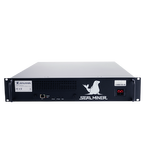
Introduction
In recent years, Bitcoin has experienced not only technical and economic transformations but also its establishment as a global force in the financial world. Its development is divided into several key phases, each with its own characteristics, challenges, and opportunities. We have delved into potential future scenarios, exploring how these eras, from the initial steps to possible futures, might change the very nature of the first cryptocurrency and its role in the global economy.
Beginning with the initial era, when Bitcoin was merely an experiment for enthusiasts and crypto-experts, we have traversed through increasingly mature stages, from the formation of an economic system to integration into mainstream finance. This article specifically focuses on how technological changes in the surrounding world affect the future of mining—from early mining farms to integration with ecological and technological innovations.
As we look at later stages of blockchain technology development, we begin to see how cryptocurrencies, especially Bitcoin, can transform not only financial systems but also the very structure of the economy, becoming an additional means of savings and a foundation for new types of financial and energy models.
What does the future hold? One thing is clear: Bitcoin will continue to evolve, creating opportunities for new participants and traditional financial players alike. We stand on the brink of a new era where technology and economics intertwine in such a way that what seems impossible today could become the standard of tomorrow.
The Sixth Era of Bitcoin
The sixth era of Bitcoin is a look into the future, where technology and economics are so deeply intertwined that the boundaries between digital and physical assets become nearly indistinguishable. This era anticipates a new stage of evolution both for Bitcoin and the global financial system, where cryptocurrency will lay the foundation for global infrastructure, and decentralization will no longer be just an ideal but an everyday reality.
While previous eras focused on recognition, institutional adoption, and technological refinement, the sixth era will be a time of mature and widespread use of cryptocurrencies at all levels: from multinational corporations to national economies and everyday users. In the sixth era, Bitcoin is expected, beyond serving as a fundamental asset or payment method, to become the basis of a new economic paradigm—a digital currency that governs global flows of value and information.
Issues of privacy, energy efficiency, and social inequality will be particularly pressing during the sixth era.
Yes, the sixth era of Bitcoin is likely, and it will be another stage in the evolution of both the technology itself and its role in the global economy. This era can be expected after 2028, following the fifth halving, when the block reward will decrease to 1.5625 BTC.
Potential Features of the Sixth Era of Bitcoin:
Bitcoin as a Global Reserve Currency
By this time, Bitcoin could become a primary international unit of account for global trade, replacing or complementing the US dollar.
Some countries might use BTC as a basis for their national currencies, especially in cases of hyperinflation.
Mass Decentralization of the Economy
Blockchain technology might integrate into all areas of life, from finance and logistics to social systems and government services.
Decentralized Autonomous Organizations (DAOs) based on Bitcoin could manage entire sectors of the economy.
Development of Second and Third Layer Technologies
Scaling solutions (e.g., Lightning Network 2.0) will allow Bitcoin to process billions of transactions per second, making it a primary payment network.
Privacy technologies and smart contracts based on BTC will be developed, enhancing its functionality.
Environmental Sustainability of Mining
Bitcoin mining will become fully reliant on renewable energy sources and integrate into the global energy system (e.g., using excess energy).
Full Integration with Artificial Intelligence and IoT
Integration of Bitcoin with Artificial Intelligence (AI) and the Internet of Things (IoT) is possible for automatic micropayments between devices.
The Future of Mining Companies in the Fifth and Sixth Eras of Bitcoin
With changes in the Bitcoin ecosystem, mining will also evolve.
Fifth Era (2024–2028): Consolidation and Sustainable Development
Sustainability and Green Energy:
The trend towards eco-friendliness: Mining companies will be compelled to use renewable energy sources to reduce carbon footprints. This will help meet regulatory requirements and maintain economic viability.
Development of mining farms in regions with cheap green energy (Northern Europe, South America, Africa).
Companies will integrate mining with energy infrastructure by using excess energy from power plants, wind, and solar farms.
Market Consolidation:
Large mining companies will dominate the market, absorbing smaller players.
A potential increase in the number of public mining companies: Listing on exchanges will provide access to additional capital.
Decentralized mining: Despite the dominance of large players, there will be a trend towards compact home miners using renewable energy.
Increased Profitability through Secondary Directions:
Mining companies could diversify their income from Bitcoin mining by offering cloud mining, staking, and computing power for other tasks (e.g., for AI).
Integration with data centers for big data processing is possible.
Regulation and Transparency:
Mining companies will have to operate under strict regulations, especially in developed countries.
Increased requirements for business reporting and transparency.
Sixth Era (2028–2032): Automation and Global Decentralization
Full Automation of Mining Operations:
Implementation of artificial intelligence (AI) and robotics to manage mining farms.
Use of blockchain technologies for automatic monitoring of equipment efficiency.
Decentralized Mining and Micromining:
Technological advancements will make mining more accessible: home devices using solar panels will allow ordinary users to participate in BTC mining.
Development of peer-to-peer mining networks: distributed resources will connect into a single network.
Energy Integration:
Mining companies will become energy hubs: mining will be integrated into city energy systems for load balancing.
Development of hybrid mining systems that use excess heat for heating homes or industrial facilities.
Sustainability and ESG Compliance:
Mining companies will be required to meet strict ESG standards (environmental, social responsibility, governance).
"Green mining" will become the norm: companies not meeting new ecological standards will be pushed out of the market.
Geopolitical Role:
Mining could become a strategic resource for countries competing for global dominance in the crypto economy.
Countries with cheap and green energy will attract mining companies through tax incentives and other benefits.
Challenges for Mining Companies:
Regulatory Pressure: Countries with negative stances on cryptocurrencies may impose restrictions, leading to farm relocations.
Decreasing Block Rewards: After the fifth and sixth halvings, mining profitability will decrease, requiring cost optimizations.
Competition with Central Bank Digital Currencies (CBDCs): Authorities may create obstacles for mining to protect their centralized currencies.
Promising Technologies for Mining Companies in the Fifth and Sixth Eras of Bitcoin
For successful adaptation to new conditions, mining companies need to focus on developing technologies that ensure overall efficiency, sustainability, and competitiveness. Key areas to focus on include:
Energy Technologies:
Renewable Energy Sources (RES):
Solar and Wind Energy: Integration of solar panels and wind turbines into mining farms to minimize dependence on traditional sources.
Geothermal Energy: Utilizing natural heat sources for mining in regions with high volcanic activity (e.g., Iceland or El Salvador).
Hydropower: Developing mining farms near hydroelectric stations to use cheap electricity.
Energy Saving and Heat Utilization:
Heat Recovery: Redirecting heat from mining devices for heating residential and industrial premises.
Energy-Efficient Cooling: Implementing immersion cooling (submerging ASIC miners in liquid) to reduce energy costs for ventilation.
Smart Energy Grids:
Creating smart grids for balancing energy consumption and integrating mining with urban energy systems.
Mining farms can act as energy buffers, consuming excess energy during low demand periods.
Equipment Innovations:
Development of Energy-Efficient ASIC Chips:
Companies should invest in developing new generations of ASICs with higher performance and lower energy consumption.
Transition to 3nm and 2nm processes to reduce electricity costs.
Modular and Portable Miners:
Developing compact miners for decentralized mining that can be used at home or in small businesses.
Implementing plug-and-play solutions for mass use.
Quantum Technologies:
Researching quantum computing for more powerful and energy-efficient mining devices.
Scaling and Optimization Technologies:
Artificial Intelligence (AI) and Machine Learning:
Applying AI for optimizing mining operations: load forecasting, energy consumption management, and equipment performance enhancement.
Automatic diagnostics: AI systems can predict equipment failures and optimize maintenance.
Decentralized Mining Networks:
Developing peer-to-peer mining platforms to distribute computing power among all users.
Technologies that unite small miners into global pools.
Cloud Mining 2.0:
Creating transparent and decentralized platforms for cloud mining with smart contracts.
Blockchain Technologies and Software:
Development of Layer-2 Solutions:
Integration with second-layer networks (e.g., Lightning Network) to reduce the load on the main network and increase transaction efficiency.
Mining and Smart Contracts:
Developing Bitcoin smart contracts for automating management of mining pools and settlements with investors.
Blockchain for Operations Management:
Developing transparent systems for managing mining companies based on blockchain technologies: energy tracking, equipment inventory management, and financial reporting.
Operational Technologies:
Robotics and Automation:
Implementing robots for automatic maintenance and repair of mining installations, especially in remote regions.
Virtual Power Plants (VPP):
Creating virtual power plants where mining farms manage energy consumption based on market conditions.
Cybersecurity and Privacy:
Quantum-Resistant Algorithms:
Developing algorithms to protect blockchain from future quantum threats.
Decentralized Security Systems:
Implementing distributed security systems to protect personal data and transactions.
Conclusion:
Bitcoin mining is not only a method of obtaining cryptocurrency but also a vital component of the entire ecosystem. In the fifth and sixth eras, when Bitcoin becomes a crucial part of the global financial structure, mining will evolve under the influence of technological, economic, and environmental factors. Bitcoin mining is expected to change dramatically, focusing on more efficient, decentralized, and environmentally sustainable solutions. Let's explore the promising directions of mining technologies in these eras.
Energy-Efficient and Eco-Friendly Solutions
In the fifth and sixth eras, energy sustainability will be a primary concern. Criticism of traditional Bitcoin mining due to its high energy consumption will likely lead to significant changes in the industry.Use of Renewable Energy Sources: In response to public pressure and the need to reduce the carbon footprint, mining will transition to using solar, wind, and hydro energy. Even now, there is a noticeable increase in the number of mining farms using green technologies. In the fifth and sixth eras, this trend will become dominant as governments and companies seek ways to minimize environmental harm and move toward carbon neutrality.
Energy Efficiency of ASICs: Improving ASIC miners (specialized integrated circuits for Bitcoin mining) will lead to reduced energy consumption per unit of mined block.
New Approaches to Energy Utilization: Using surplus energy (e.g., energy excess in remote regions) for mining could become standard.
Decentralization of Mining and New Distributed Networks
In the fifth and sixth eras, strengthening the decentralization of mining will be a crucial part of the overall development strategy. Given that decentralization is one of Bitcoin's main advantages, mining will adapt to the needs and challenges of new economic realities.Mining within Distributed Networks: In response to the threat of centralization of mining powers (where large mining companies control most of the computing power), new forms of distributed mining are being developed, which could include broader involvement of regular users through peer networks and smartphones. In the sixth era, solutions will be developed that allow users with home PCs or smartphones to participate in mining, reducing the concentration of computing power in the hands of major players.
Proof-of-Useful-Work Protocols (PoUW): Instead of using excess computing power solely for mining, new algorithms will be implemented to use miners' computing resources for solving useful tasks (e.g., for scientific research, combating climate change, or other projects with real social value). In the sixth era, such technologies could become standard practice, promoting the idea of mining as part of the public good.
Development of Energy Storage and Processing Technologies
Related to the previous point, effective mining will require a more intelligent approach to energy management, leading to increased demand for energy storage and processing.Energy Storage Systems: The future will see further development of energy storage solutions, like lithium-ion batteries or gravitational energy storage systems, which are used for storing energy generated during periods of low demand (e.g., when excess energy is available from wind or solar power plants). Mining farms can become significant consumers of such systems, providing stability and balance in distributed energy networks.
Energy Recycling and Recirculation: Applying technologies for heat recycling (e.g., converting heat generated by mining equipment into useful energy) will also develop, allowing more efficient energy use and reducing overall mining costs.
Application of Quantum Technologies and Artificial Intelligence
In the more distant future, mining may change significantly with the development of new technologies such as quantum computing and artificial intelligence (AI).Quantum Computing: Theoretically, quantum computers could be used to speed up the mining process, significantly increasing computation speed. However, in practice, quantum computing could also pose a security threat to blockchains, as they might crack current cryptographic protection algorithms. In the sixth era, new algorithms will be developed to protect against quantum attacks.
Artificial Intelligence: AI for optimizing mining processes—from improving farm operations to managing energy distribution—will become a significant part of the ecosystem. AI systems can analyze cryptocurrency market data and energy consumption trends, predicting the best times for mining and mining pool selection.
New Format of Mining Pools and Participation Flexibility
Mining in the fifth and sixth eras will become more flexible and accessible for participants with different resources and needs.Next-Generation Mining Pools: Mining pools will evolve towards greater inclusivity and openness, allowing users with fewer computing resources to participate in Bitcoin mining but with greater benefits through collective power and innovative reward distribution algorithms.
Financial and Social Responsibility: In these eras, there will also be increased interest in socially responsible Bitcoin mining. Mining pools and companies will strive to increase transparency in their operations, adhere to environmental standards, and create sustainable business models.
Bitcoin mining in the fifth and sixth eras will evolve in response to global challenges: from economic and environmental sustainability to technological breakthroughs. Energy efficiency, decentralization, and innovative approaches to using computing power will be key factors shaping the future of mining. In these eras, Bitcoin mining will develop to become a significant part of the global financial and social structure, with profound implications for the economy and society.






















